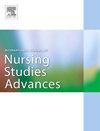护理学生对儿童病情恶化的信号检测:一项解释性序列设计混合方法研究
IF 3.1
Q1 NURSING
International Journal of Nursing Studies Advances
Pub Date : 2025-08-29
DOI:10.1016/j.ijnsa.2025.100415
引用次数: 0
摘要
目的:在疾病并发症或病情恶化的早期阶段,护士未能及时发现有临床意义的变化信号,导致抢救失败。儿科患者的病情恶化检测带来了不同的挑战,因为儿科患者的生理反应与成人不同。由于成人疾病是护理教育的主要重点,护理专业的学生在发现儿科患者病情恶化方面尤其面临挑战。本研究旨在识别护生归类为儿科恶化信号的生命体征,确定其对信号反应的影响,以及这些影响如何影响其在信号检测试验中的表现。方法采用解释性序列混合方法设计,对护理专业本科二学期学生的儿科病情恶化检测能力进行评估和了解。学生们参加了信号检测试验,然后对其中一部分人的表现和思维处理进行了采访。对定量数据进行描述性统计、平均率、敏感性和反应偏倚分析。对定性数据进行专题分析。对定量和定性结果进行比较,以检验绩效和对反应的影响是如何相关的。结果研究对象(n=21)对儿童病情恶化信号的敏感度较低(d ' = 1.19 (SD 0.85)),将非关键刺激误分类为病情恶化指标的倾向增加(c = -0.03 (SD 0.66))。在所有信号类型中,呼吸频率变化是最准确识别的。生命体征类型对检测无显著影响。四个主要主题被确定为影响学生在试验中的反应的因素。检测性能的差异对应着影响因素的差异。结论学生对患者病情恶化早期体征的敏感度较低。这些发现强调需要加强学生的知识和准备,以便及早发现儿童病情恶化的信号,减少抢救失败。本研究展示了创新的使用信号检测来评估护理学生识别病人恶化线索的能力。通过量化敏感度指数和反应偏差,教育工作者可以识别知识差距,并根据个人需求量身定制补救措施。信号检测测试提供了一个独特的框架来评估不确定性下的决策,促进护理教育,使学生更好地为临床实践做好准备。本文章由计算机程序翻译,如有差异,请以英文原文为准。
Signal detection for pediatric patient deterioration with nursing students: An explanatory sequential design mixed-methods study
Objective
Failure to rescue occurs when nurses fail to detect signals of clinically significant changes in the early stages of disease complication or patient deterioration. Pediatric patient deterioration detection poses a different challenge because pediatric patients physiologically respond differently from adults. Nursing students are especially challenged in detecting pediatric patient deterioration because adult illness is the primary focus of nursing education. The study aims to identify vital signs that nursing students categorize as signals of pediatric deterioration, determine influences on their response to signals, and how these influences affect their performance in signal detection trials.
Methods
To assess and understand nursing students’ pediatric deterioration detection performance, an explanatory sequential mixed-method design was conducted with second-semester senior baccalaureate nursing students. Students participated in signal detection trials, and then a subset was interviewed about their performance and thought processing. The quantitative data were analyzed for descriptive statistics, mean rate, sensitivity, and response bias. The qualitative data were analyzed with thematic analysis. The quantitative and qualitative results were compared to examine how performance and influences on response are related.
Results
Participants (n=21) had a low sensitivity d’ = 1.19 (SD 0.85) to signals of pediatric deterioration and an increased tendency c = -0.03 (SD 0.66) to misclassify non-critical stimuli as indicators of deterioration. Respiratory rate changes were the most accurately identified among all signal types. Vital sign type did not significantly affect detection. Four major themes were identified as factors influencing student responses in the trials. Differences in detection performance corresponded with differences in influencing factors.
Conclusion
Students demonstrated low sensitivity in detecting early signs of patient deterioration. These findings highlight the need to enhance student knowledge and preparedness to detect signals of pediatric deterioration early and reduce failure to rescue. This study demonstrates the innovative use of signal detection to assess nursing students’ ability to recognize patient deterioration cues. By quantifying the sensitivity index and response bias, educators can identify knowledge gaps and tailor remediation to individual needs. Signal detection testing provides a unique framework to evaluate decision-making under uncertainty, advancing nursing education to better prepare students for clinical practice.
求助全文
通过发布文献求助,成功后即可免费获取论文全文。
去求助
来源期刊

International Journal of Nursing Studies Advances
Nursing-General Nursing
CiteScore
5.80
自引率
0.00%
发文量
45
审稿时长
81 days
 求助内容:
求助内容: 应助结果提醒方式:
应助结果提醒方式:


